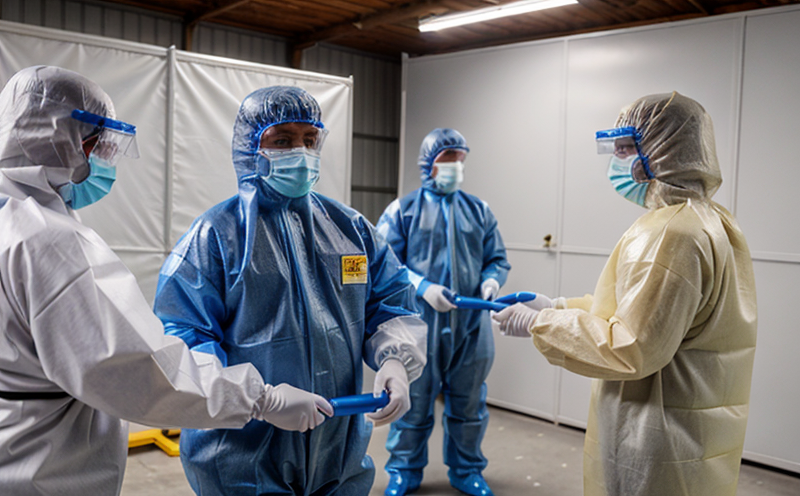Protective Clothing Testing
The testing of protective clothing is a critical aspect within the textile sector. Protective clothing, such as suits worn by first responders, medical professionals, and industrial workers, must meet stringent standards to ensure it provides adequate protection against various hazards. This service involves rigorous evaluations using international standards like ISO 16703 for chemical resistance or ASTM F1506 for flame resistance.
Protective clothing is designed to protect the wearer from a wide array of potential threats, including chemicals, heat, fire, and mechanical abrasions. Testing laboratories play a vital role in verifying that these garments meet the necessary performance criteria set by regulatory bodies worldwide.
The testing process typically involves several stages:
- Sample preparation: This includes ensuring the sample is cut from the fabric to replicate real-world conditions as closely as possible.
- Instrumentation: High-precision equipment such as calorimeters or permeation testers may be used depending on the type of test being conducted.
- Data analysis: Results are carefully analyzed to determine if they meet specified thresholds outlined by relevant standards.
The results from these tests are essential for both manufacturers and end-users. They provide assurance that protective clothing will perform as intended under various conditions. This is particularly important given the diverse range of hazards encountered across different industries.
For instance, in emergency response scenarios, firefighters need garments capable of resisting high temperatures while also offering protection against toxic substances. In medical settings, healthcare workers rely on isolation gowns that can effectively block pathogens. By adhering to strict testing protocols, we ensure these expectations are met consistently across all products.
This service is not only about meeting regulatory requirements but also about enhancing product performance through continuous improvement based on test results.
Why It Matters
The importance of protective clothing testing cannot be overstated. When working in environments where safety is paramount, every second counts. Ensured by thorough laboratory evaluation, this service ensures that workers are equipped with garments that can withstand the challenges they face daily.
- Enhanced Safety: Properly tested protective clothing significantly reduces risk exposure for those who wear them. This leads to fewer injuries and illnesses among employees across various sectors.
- Innovation Drive: Through rigorous testing, manufacturers can identify areas for improvement in their products. Continuous innovation helps keep up with changing safety standards and emerging threats.
- Regulatory Compliance: Meeting regulatory requirements ensures compliance with laws set forth by organizations like OSHA or EN ISO 16703. Failure to comply could result in penalties or product recalls.
In an era where worker health and safety are increasingly prioritized, the role of protective clothing testing becomes even more crucial. It serves as a cornerstone for maintaining high standards across industries that depend on personal protective equipment (PPE).
Moreover, by adhering to international standards such as ISO 16703 or ASTM F1506, laboratories contribute to global consistency in PPE quality assurance.
Benefits
- Improved Product Quality: Testing ensures that protective clothing meets the highest standards, leading to superior product performance and reliability.
- Increased Safety: By identifying potential weaknesses early on, manufacturers can make necessary adjustments before products reach consumers or end-users.
- Enhanced Reputation: Demonstrating commitment to quality control builds trust among customers and stakeholders alike. This is especially valuable in competitive markets where brand reputation plays a significant role.
- Compliance with Regulations: Ensuring compliance helps avoid legal issues and potential financial penalties associated with non-compliance.
The benefits extend beyond just the manufacturer; they also positively impact end-users by providing peace of mind knowing that their protective clothing has been thoroughly vetted for safety and effectiveness.
International Acceptance and Recognition
The acceptance and recognition of protective clothing testing are integral to maintaining global standards in the industry. Laboratories accredited according to ISO 17025 or EN ISO/IEC 17025 ensure that their methodologies adhere strictly to international best practices.
- Global Standards: Adherence to internationally recognized standards like ISO 16703 and ASTM F1506 guarantees uniformity in testing procedures, making results universally applicable.
- Trusted Results: When a laboratory is certified by bodies such as ANSI or UKAS, it adds credibility to the test outcomes. Employers worldwide can rely on these reports knowing they meet stringent quality controls.
The widespread acceptance of such testing ensures that protective clothing remains effective and safe across borders. This is particularly beneficial for multinational companies operating in multiple countries where local regulations may differ slightly but require consistent PPE performance standards.
By upholding these high standards, laboratories contribute to a safer work environment globally while fostering trust between manufacturers, distributors, and end-users.





